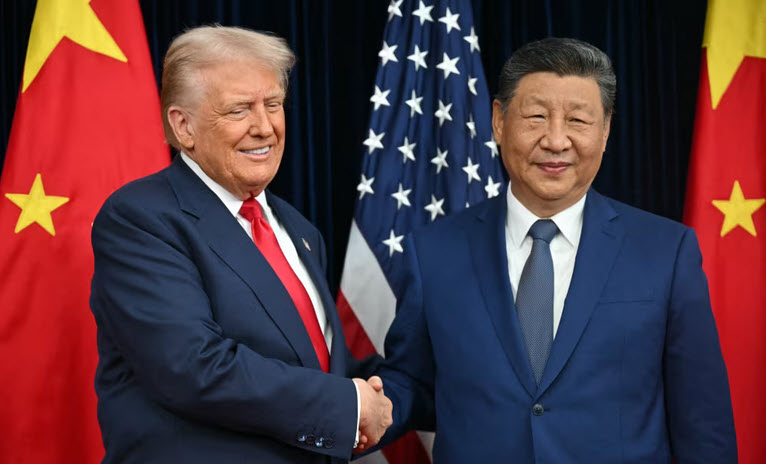Moving on from Big Tech - what's next?

The repricing of Big Tech, whether it manifests itself precipitously or glacially, will still manifest itself over time, and as such, we’re moving on (for now).
But that doesn't mean there aren't other themes to invest in. Big Tech overvaluation is quite a specific risk, not a universal equity market risk. Sure, if it manifests itself quickly, it would cause a significant drop in the headline S&P 500 and NASDAQ indices, and it would impact risk-on sentiment and all markets, but it would ultimately be confined in the fall, as it was in the rise, to the Rock in a Sock stocks, and there aren’t that many of them.
Meanwhile, the US economy is doing OK, the results season has been great (average earnings growth of 12.5% v consensus at 7.9%), interest rates are coming down, QT is ending (that’s like another rate cut), tariff tension has disappeared, inflation is still trending lower and not every stock in the world is in the overvalued Magnificent 6 (ignore Tesla).
In fact, not all stocks in the Magnificent 6 are as overvalued as every other stock in the Magnificent 6 – and there are another Magnificent 30 AI-related Chip, Cloud and Tech stocks that all deserve to be viewed on their individual merits, not as Nvidia equivalents.
Within the Magnificent 6, Nvidia now stands out as the most overvalued Big Tech, having recently jumped 20.1% in six days, rising by more than the market cap of the CBA in one day after the “AI Super Bowl” GTC conference. It has since dropped 10.4% in six days. It is arguably now the most vulnerable Big Tech stock on a PE of 65.3x, dropping to 43.2x.
As they say: A Porsche is a fast and sexy car, but you wouldn’t pay $1 million for a Porsche, no matter how fast or sexy it is.
.png)
Some Big Tech stocks are unquestionably overvalued on current earnings, with share prices supported by sentiment towards future earnings, which the market is beginning to realise might not materialise.
If the market lost its enthusiasm for a stock on 32x and returned it to the S&P 500 average of 22-25x, then the stock would fall 22%-31%.
The MAG6 market cap is $20.239 trillion. It trades on an average 32.2x future earnings. Apple is on 32.8x. Nvidia 43.2x. Microsoft 30.8x. Amazon 35.2x. Meta 23.6x. Alphabet 26.9x. You do the numbers.
And they are trading 47%, 48%, 60%, 50%, 66% and 61% above intrinsic value (but who cares about value right? So 1980's)
Palantir is even worse on overvaluation concerns (PE of 272x and price to sales of 161x), and the Palantir CEO’s tirade against Michael Burry's short selling this week displayed a remarkable naivety about how the stock market works. That in itself is a Red Flag. CEOs and their egos are obsessed with today's ridiculous share price.
It was the sort of thing you look back on years later when Palantir is back on a PE of 22x and say “Do you remember the Palantir CEO spitting the dummy about Michael Burry shorting his stock. Now that was the top”. I'm with Michael Burry.

Bottom Line – We’re out of Big Tech as a theme; we were hanging out there a bit, very successfully, but we were overexposed to a single theme. We now look for a re-entry at a more sensible price, and our antennae are up, as we look out for another theme or two that has the potential to deliver growth without significant risk.
We are in no rush. Technically, a lot of charts are showing signs of topping out, and if Big Tech does crack fast (or slow), the rest of the market is going to struggle to lift.
Without the Big Tech frenzy in full flight, there’s a good chance that the era of easy gains in a Tech-led bull market has matured, and without the Big Tech herd, it’s not going to be quite as easy to achieve our 20% ambition as it has been (unless Big Tech resets suddenly and gives us an irresistible buying opportunity).
As for new themes – we have some ideas – we are concerned that some of the resources-based themes that have long-term potential (Uranium, Copper) have become volatile. It’s a crap shoot from one day to another. We need reliable. Coming out of a market slump, we may get that, but at the peaks here, it's choppy. Too choppy.
One theme that we are investigating is China-related ETFs. The intriguing attraction is that the Chinese government has a certainty of purpose outlined in its five-year plans that outline policy intentions that have longevity and integrity. They have policy stability, something Western politicians can only dream of.
The latest five-year plan is highly nationalistic. China is for China, and their experience with Trump and tariffs has cemented an intention to gain independence from US influence, which includes dependence on US imports, dependence on the US as an export customer, dependence on the US dollar as a reserve currency and dependence on the US for technology, specifically, chips and AI. As the AFR recently wrote, "China could be well-positioned to seize the lead on AI’s real-world applications if the proposals pan out" and "China will take 'extraordinary measures' to drive domestic breakthroughs in semiconductors, industrial machine tools, advanced materials, and biomanufacturing, among other areas". As the AFR says, Chinese stimulation of national industries and technology stocks without interference and committee is an 'unbeatable strategic advantage'.
China also declared an intention to stimulate domestic consumption, and let's be clear, domestic consumption of Chinese, not US goods.
Whilst Xi Jinping smiled and shook hands at Trump's tariff negotiation (photo op) and did a deal on rare earths and soybeans (irrelevant), they have almost certainly walked away vowing to distance themselves from the US muppetry as soon as possible, and their five-year plan embodies that intention.
China is long-term and predictable. Trump is short-term and volatile. Where would you prefer to invest?
China's nationalistic determination to invest in itself is shaping up as a theme, and amazingly enough, we have access to Chinese stocks through ETFs. The ETFs pick themselves.
But again, if Big Tech in the US falls over first, the Supreme Court rules tariffs are illegal, the Nvidia results on the 19th miss in any way, or the US data dump after the US government shutdown doesn't impress, and the Fed don't cut rates as expected, nothing is going up for the moment.
So timing will be everything. As always.
We’ll keep on it.

Marcus Padley manages the MT20 Portfolio which uses Australian-listed ETFs to time the market and market themes. Marcus is the founder of the Marcus Today Stock Market Newsletter established in 1998. Motto - "Inform, Explain, Educate and Entertain".
.jpg)
5 topics

